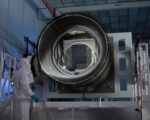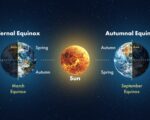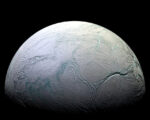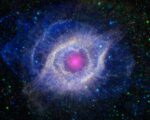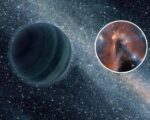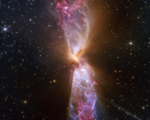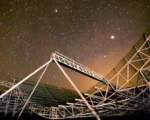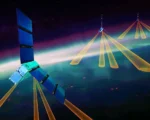The James Webb Space Telescope (JWST) has captured the stunning details of the Hourglass Nebula, also known as Lynds 483 (LBN 483), located around 650 light-years from Earth. This remarkable nebula is shaped by the dynamic interactions between two young stars at its core. These stars, in the early stages of their formation, drive powerful outflows that expel gas and dust into space, sculpting the surrounding nebula into a striking hourglass shape. As material from a collapsing molecular cloud feeds into these stars, energetic bursts of gas and dust are expelled, influencing the shape and evolution of the nebula. Over time, the interaction of stellar winds and jets with the surrounding matter continues to refine this fascinating structure, offering new insights into the processes involved in star formation.
The two protostars at the heart of LBN 483 are central to the formation and ongoing evolution of the nebula. The presence of a lower-mass companion star, detected in 2022 by the Atacama Large Millimeter/submillimeter Array (ALMA), suggests complex interactions within the star system. These interactions lead to periodic bursts of gas and dust as material accreted onto the stars triggers energetic outflows. These outflows, in turn, collide with the surrounding gas and dust, creating intricate structures within the nebula, such as dense pillars and shock fronts where freshly ejected material meets older expelled gas. JWST’s infrared imaging capabilities have allowed scientists to observe these features in unprecedented detail, providing a clearer picture of the dynamic processes that shape the nebula.
The role of magnetic fields in shaping the nebula’s structure has also become a focal point of recent studies. ALMA’s radio observations have detected polarized emissions from cold dust within the nebula, signaling the presence of a magnetic field that influences the direction and structure of the outflows. The magnetic field plays a crucial role in guiding the energetic jets and winds emanating from the protostars. One of the most intriguing discoveries is a 45-degree kink in the magnetic field, located about 1,000 astronomical units away from the stars. This deviation is believed to be caused by the migration of the secondary star over time, which alters the system’s angular momentum. As the stars continue to interact, the shape and direction of the nebula’s outflows are constantly influenced, providing further insight into the complex dynamics of stellar formation.
These findings emphasize the importance of both stellar interactions and magnetic fields in shaping nebulae like LBN 483. By capturing this nebula in extraordinary detail, the James Webb Space Telescope offers a rare glimpse into the dynamic processes that govern star formation. The study of such structures not only enhances our understanding of the birth and evolution of stars but also provides valuable clues about the forces that influence the development of complex cosmic structures.



